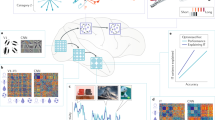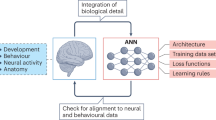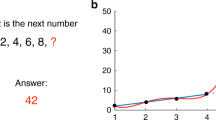Abstract
The first issue of Nature Reviews Neuroscience was published 20 years ago, in 2000. To mark this anniversary, in this Viewpoint article we asked a selection of researchers from across the field who have authored pieces published in the journal in recent years for their thoughts on notable and interesting developments in neuroscience, and particularly in their areas of the field, over the past two decades. They also provide some thoughts on current lines of research and questions that excite them.
The contributors
Danielle S. Bassett is the J. Peter Skirkanich Professor at the University of Pennsylvania, Departments of Bioengineering, Electrical and Systems Engineering, Physics and Astronomy, Neurology, and Psychiatry. Her expertise centres on the architecture, function, design and control of complex systems, with a particular focus on large-scale neural systems in humans.
Kathleen E. Cullen is a professor of biomedical engineering at the Johns Hopkins University School of Medicine. She holds joint appointments in neuroscience and in otolaryngology. Her expertise in systems and computational neuroscience uses state-of-the-art methodologies that manipulate and monitor neural circuits to understand the neural computations that predict the consequences of natural self-motion and the implications for perception and action.
Simon B. Eickhoff is a neuroimaging researcher at the Heinrich-Heine University Düsseldorf and the Forschungszentrum Jülich. At the interface between neuroanatomy, data science and medicine, his work combines brain mapping, modelling of inter-individual differences and brain–phenotype relationships as well as machine learning for single subject prediction of behavioural traits and precision medicine.
Martha J. Farah is a cognitive neuroscientist at the University of Pennsylvania, where she directs the Center for Neuroscience & Society. Her current research is focused on the relations between socio-economic status and the brain.
Yukiko Goda is Deputy Director and a team leader at the RIKEN Center for Brain Science. Her research addresses the cellular principles by which synaptic strengths are set and dynamically modified at individual synapses in relationship to other synapses in defined neural circuits. Recent efforts in the group also target roles for astrocytes in synapse regulation.
Patrick Haggard leads the ‘Action and Body’ research group at the Institute of Cognitive Neuroscience, University College London.
Hailan Hu is a professor at Zhejiang University School of Medicine, China. Her research interest focuses on how emotional and social behaviours are encoded and regulated in the brain, with a main focus on the neural circuitry underlying depression and social dominance.
Yasmin L. Hurd is Professor of Psychiatry, Neuroscience and Pharmacological Sciences at the Icahn School of Medicine in New York and Director of the Addiction Institute in the Mount Sinai Behavioural Health System. Her research focuses on opioid abuse and the developmental consequences of early drug exposure (particularly cannabis) using multidisciplinary and translational approaches in humans and animal models.
Sheena A. Josselyn is Senior Scientist at the Hospital for Sick Children (SickKids), a Professor at the University of Toronto in Canada and a Senior Fellow in the Canadian Institute for Advanced Research (CIFAR). She is interested in understanding how the brain uses information. Her laboratory uses a variety of experimental techniques to probe memory function in mice.
Baljit S. Khakh is a Professor of Physiology and Neurobiology at University of California Los Angeles. His expertise centres on glial biology and the role of astrocytes in neural circuits. The Khakh laboratory develops and uses novel genetic and optical methods to explore glial biology in vivo.
Jürgen A. Knoblich is Director of the Institute of Molecular Biotechnology of the Austrian Academy of Sciences in Vienna. He is a developmental neuroscientist studying human brain development and psychiatric disorders. Researchers in his group have developed a method for growing human brain tissue in the laboratory. They can recapitulate human embryonic brain development during the first trimester and analyse the developmental defects leading to neurological disorders.
Panayiota Poirazi is a Research Director at the Foundation for Research and Technology-Hellas (FORTH) in Heraklion, Crete, Greece. She uses mathematical and computational techniques to develop experimentally constrained models of single neurons and neuronal networks, aiming at inferring the contributions of dendritic computations to complex brain functions.
Russell A. Poldrack is the Albert Ray Lang Professor in the Department of Psychology and Professor (by courtesy) of Computer Science at Stanford University, and Director of the Stanford Center for Reproducible Neuroscience. His research uses neuroimaging to understand the brain systems underlying decision-making and executive function. His laboratory also develops neuroinformatics tools to help improve the reproducibility and transparency of neuroscience.
Marco Prinz is a neuropathologist at the University of Freiburg, Germany. Currently, his research group aims to understand myeloid cell biology in the CNS during health and disease and studies the impact of the CNS endogenous immune system on the pathogenesis of neurological disorders such as neurodegenerative and neuroinflammatory diseases.
Pieter R. Roelfsema has been Director of the Netherlands Institute for Neuroscience, Amsterdam, since 2007. He studies visual perception and perceptual organization, as well as plasticity rules. He aims to develop a neuroprosthesis for the visual cortex to restore a rudimentary form of vision in blind individuals.
Tara Spires-Jones is Professor of Neurodegeneration and a UK Dementia Research Institute Group Leader at the University of Edinburgh. Her group studies the role of synapses in brain degeneration and resilience. Using pioneering imaging techniques, her group has discovered links between genetic risk factors for Alzheimer disease and synaptic degeneration.
Mriganka Sur is a neuroscientist at the Massachusetts Institute of Technology, where he directs the Simons Center for the Social Brain. His laboratory studies mechanisms of brain wiring and processing, especially in the cerebral cortex, and how they go awry in disorders of brain development.
Hiroki R. Ueda is a professor at the University of Tokyo and a team leader in RIKEN BDR. He has an expertise in systems biology and focuses on mammalian sleep–wake cycles. He invented the whole-brain and whole-body clearing and imaging methods called CUBIC and the next-generation mammalian genetics for one-step production and analysis of knockout and knock-in mice without crossing.
This is a preview of subscription content, access via your institution
Access options
Access Nature and 54 other Nature Portfolio journals
Get Nature+, our best-value online-access subscription
$29.99 / 30 days
cancel any time
Subscribe to this journal
Receive 12 print issues and online access
$189.00 per year
only $15.75 per issue
Buy this article
- Purchase on Springer Link
- Instant access to full article PDF
Prices may be subject to local taxes which are calculated during checkout
Similar content being viewed by others
Acknowledgements
D.S.B. is grateful to the mentees, colleagues and mentors who constantly broaden her appreciation of the diversity of scientific inquiry and deepen her excitement to pursue the most puzzling questions. K.E.C. was supported by the National Institutes of Health (NIH; grant numbers DC002390, DC018061 and UF1 NS111695). S.B.E. is supported by the Deutsche Forschungsgemeinschaft (DFG; EI 816/16-1 and EI 816/21-1) and the European Union’s Horizon 2020 Research and Innovation Programme under Grant Agreement No. 945539 (HBP SGA3) and 826421 (Virtual Brain Cloud). Y.G. is supported by funds from the RIKEN Center for Brain Science, The Uehara Memorial Foundation and the Japan Society for the Promotion of Science (JSPS) Core-to-Core Program A Advanced Research Networks. P.H. is partly supported by a joint grant from the John Templeton Foundation and the Fetzer Institute. The opinions expressed in this publication are those of the author(s) and do not necessarily reflect the views of the John Templeton Foundation or the Fetzer Institute. Furthermore, P.H. was supported by a Chaire de Recherche Jean D’Alembert held at Paris-Saclay University, and from a fellowship at the Paris Institute for Advanced Study (France), with the financial support of the French State, programme ‘Investissements d’avenir’ managed by the Agence Nationale de la Recherche (ANR-11-LABX-0027-01 Labex RFIEA+). H.H. is supported by grants from the National Natural Science Foundation of China (31830032 and 81527901) and the Fountain-Valley Life Sciences Fund of University of Chinese Academy of Sciences Education Foundation. Y.L.H. is supported by grants DA050323, DA048613, DA043247 and DA030359 from the National Institute of Drug Abuse (NIDA). S.A.J. acknowledges discussions with P. W. Frankland (SickKids) and members of the Josselyn and Frankland laboratories for continued inspiration. B.S.K. is supported by the NIH (NS111583 and MH104069), CHDI Inc., an Allen Distinguished Investigator Award through The Paul G. Allen Frontiers Group, a UCLA David Geffen School of Medicine Seed Grant and the Ressler Family Foundation. J.A.K. would like to thank all his lab members for exciting discussions. Work in J.A.K.’s laboratory is supported by the Austrian Federal Ministry of Education, Science and Research, the Austrian Academy of Sciences, the Austrian Science Fund (Z_153_B09), the City of Vienna and the European Research Council (ERC, grants 695642 and 693184). P.P. thanks the members of her laboratory (www.dendrites.gr) for their dedication and hard work. Her laboratory is funded by the European Union’s Horizon 2020 research and innovation programme (FET Open RIA GA 863245: NEUREKA, MC RISE GA 873178 INAVIGATE), the EINSTEIN Foundation-Berlin and the Fondation Santé. M.P. is supported by the Sobek Foundation, the Ernst-Jung Foundation, the DFG (SFB 992, SFB1160, SFB/TRR167, Reinhart-Koselleck Grant and Gottfried Wilhelm Leibniz Prize) and the Ministry of Science, Research and Arts, Baden-Wuerttemberg (Sonderlinie ‘Neuroinflammation’). M.P. is further supported by the DFG under Germany’s Excellence Strategy (CIBSS — EXC-2189 — Project ID390939984). P.R.R. was supported by the Netherlands Organization for Scientific Research (NWO; grant P15-42 ‘NESTOR’), the European Union’s Horizon 2020 Framework Programme Agreement No. 650003 (HBP FPA) and the Friends Foundation of the Netherlands Institute for Neuroscience. T.L.S.-J. is funded by the European Research Council (ERC) under the European Union’s Horizon 2020 research and innovation programme (Grant agreement No. 681181), the UK Dementia Research Institute — which receives its funding from DRI Ltd, funded by the UK Medical Research Council, Alzheimer’s Society and Alzheimer’s Research UK — and the University of Edinburgh. M.S. thanks the members of his laboratory for their comments. Research in the laboratory of M.S. is supported by NIH grants EY028219, MH085802 and DA049005, and the Simons Foundation Autism Research Initiative. H.R.U. is supported by Brain/MINDS JP21dm0207049, Science and Technology Platform Program for Advanced Biological Medicine JP21am0401011, Grant-in-Aid for Scientific Research (S) JP25221004 (JSPS KAKENHI) and HFSP Research Grant Program (HFSP RGP0019/2018).
Author information
Authors and Affiliations
Contributions
The authors contributed equally to all aspects of the article.
Corresponding authors
Ethics declarations
Competing interests
P.R.R. is a co-founder of and shareholder in a neurotechnology start-up, Phosphoenix (Netherlands). T.L.S.-J. receives collaborative funding from three industry partners (Autifony, Cognition Therapeutics and one anonymous industry donor), is on the Scientific Advisory Board of Cognition Therapeutics and is an editor for several journals, including founding Editor in Chief of Brain Communications. None of these influenced this piece. D.S.B., K.E.C., S.B.E., M.J.F., Y.G., P.H., H.H., Y.L.H, S.A.J., B.S.K., J.A.K., P.P., R.A.P., M.P., M.S. and H.R.U. declare no competing interests.
Additional information
Publisher’s note
Springer Nature remains neutral with regard to jurisdictional claims in published maps and institutional affiliations.
Related links
anneslist: https://anneslist.net/
BiasWatchNeuro: https://biaswatchneuro.com/
Women in Neuroscience Repository: https://www.winrepo.org/
Rights and permissions
About this article
Cite this article
Bassett, D.S., Cullen, K.E., Eickhoff, S.B. et al. Reflections on the past two decades of neuroscience. Nat Rev Neurosci 21, 524–534 (2020). https://doi.org/10.1038/s41583-020-0363-6
Accepted:
Published:
Issue Date:
DOI: https://doi.org/10.1038/s41583-020-0363-6
This article is cited by
-
Bridging functional and anatomical neural connectivity through cluster synchronization
Scientific Reports (2023)
-
State-dependent effects of neural stimulation on brain function and cognition
Nature Reviews Neuroscience (2022)
-
Hemispheric asymmetries in visual mental imagery
Brain Structure and Function (2022)
-
Turning twenty
Nature Reviews Neuroscience (2020)



